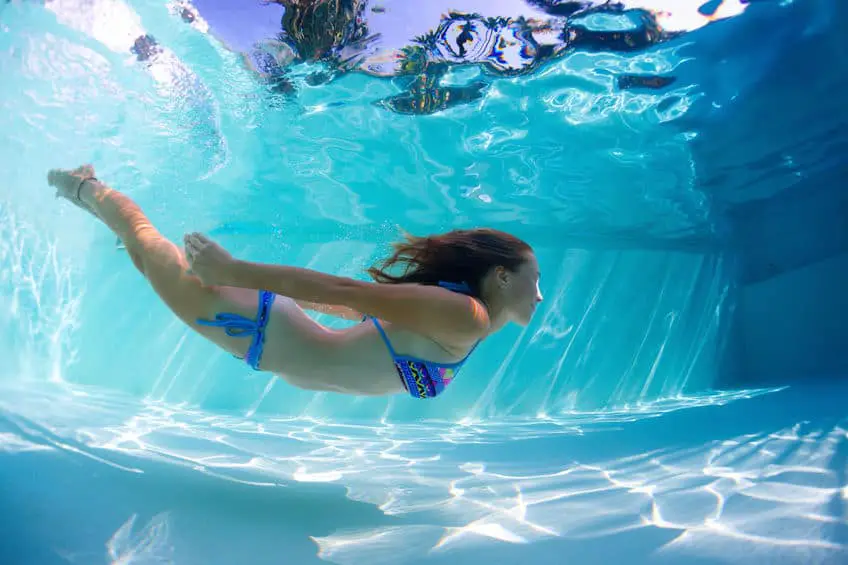The salt chlorinator system is what turns a regular pool into a salt water one. A salt system typically consists of a main control unit plus a salt cell and a water flow sensor that are integrated into the piping. Collectively, they enable your pool to produce chlorine with dissolves salt that you add to the pool water.
You can of course build a salt water pool from scratch but not all types of pools are necessarily recommended to be salt water pools While you can also convert some existing pools into a salt water pools, some existing pools may not be suitable either.
We’ll discuss these issues plus other aspects of the salt water chlorination concept below.
What does a salt chlorination system consist of?
A typical salt chlorinator system consists of the control panel itself which houses the computer and manages the system as a whole. It’s often a large metal box and is set up near the pool equipment by the pump, etc.
The second key part of the system is the salt cell. It’s a plastic tube that fits right into the existing pool plumbing. Inside the salt cell are rows of metal plates. The plates are electrified with a low current so when salt water runs through the cell, chlorine is produced to sanitize the pool.
The third major part of the system is the water flow sensor which monitors the water running through the system and ensures that the the flow rate is enough. If the flow rate drops too low, the sensor lets the system know and shuts down the chlorinator down to protect it from damage.
As water passes through the salt cell, the process continues and free chlorine keeps getting produced over time to replace chlorine that has been used up.
Can any pool be converted into a salt water pool?
In general terms, an existing vinyl liner pool and fiberglass pool are excellent candidates to be converted to a salt water pool. Depending on who you ask, a concrete or gunite pool could be too but it’s a bit of a debate.
Most pool pros will tell you that a vinyl liner or fiberglass pool are great candidates for a salt water system. Vinyl and fiberglass hold up well to salt water so there is no problem there. There’s a reason why boatmakers have used fiberglass to build boats and pleasure crafts for decades, right? It’s a tough substance that holds up well to salt water as does vinyl.
Concrete and gunite pools are a different story. You can do an online search and you’re likely to find a split between people who say you can use a salt water system with your concrete or gunite pool and another side who say no way!
In fact you’ll find some pool companies that won’t build a concrete or gunite pool with a salt water system full stop. Presumably they don’t want the hassle should the salt water prematurely wear or otherwise damage the concrete.
The salt content in a pool is relatively low (2700 ppm to 3400 ppm is the ideal range) which is far lower than say the ocean which is 35,000 ppm (parts per million).
Click here for my article comparing vinyl, concrete and fiberglass pools to learn more.
How often do you run the salt water chlorinator?
If you run your pool pump for 8 – 10 hours per day, you can typically set your chlorinator to run 50% of the time and then adjust up or down as needed. This is a good starting point for the average pool owner.
A rule of thumb is that you should run your pump and chlorinator enough that the water is turned over twice per day or every 12 hours. Some people shoot for a turnover of every 6 hours. Turnover refers to the entire amount of water in the pool being run through the pump and filter during a 24 hour period.
Check out my article called 5 Ways To Reduce Energy Costs (Salt Water Pool) to learn not only about how to calculate your pool’s turnover rate and required pump time, but several methods to save money on your salt water pool, too.
Comparing the pump run time and chlorinator run time
The question of chlorinator run time does need some clarification. First off, the pool pump has to be running for the chlorinator to operate. So if the pump is off, the chlorinator can’t run and thus no chlorine will be produced.
But just because the pump is running, doesn’t mean the chlorinator is actively running and producing chlorine either.
Using the above numbers: If you run your pool pump 8 hours per day and have the chlorinator set at 50%, that means that 50% of the time the pump is running, the chlorinator will operate too and will be producing chlorine.
8 hours X 50% = 4 hours per day. So you’re producing chlorine for 4 hours each day at this setting.
Using the 8 hour pump time and 50% chlorinator setting, that means the pump will be running for 4 hours each day with no chlorine being produced.
Summary
A salt chlorinator system is what turns a regularly chlorinated pool into a salt water pool. It’s the system that takes dissolved salt that has been added to the pool and converts it to chlorine.
If you find that you need more chlorine, you can increase the pump time and/or increase the chlorinator setting.
If you find that you need less chlorine, you can decrease the pump time and/or decrease the chlorinator setting.
Over time you will see what works for you based on your pool’s water volume, sun exposure, pool usage, etc.
Personally, I run my chlorinator as low as 40% and the pump no more than 8 hours per day and it seems to work just fine for my pool.

